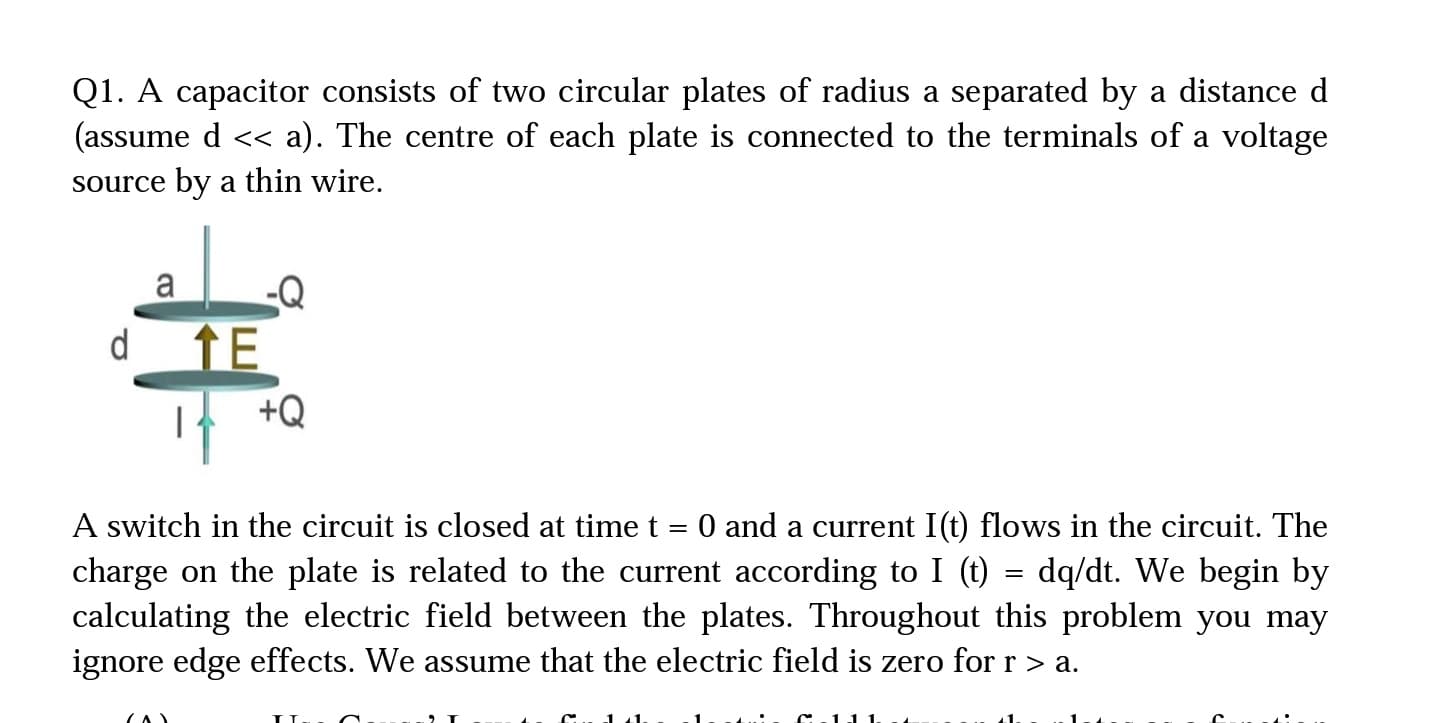Q1. A capacitor consists of two circular plates of radius a separated by a distance d (assume d << a). The centre of each plate is connected to the terminals of a voltage source by a thin wire. a d TE +Q A switch in the circuit is closed at time t = 0 and a current I(t) flows in the circuit. The charge on the plate is related to the current according to I (t) calculating the electric field between the plates. Throughout this problem you may ignore edge effects. We assume that the electric field is zero for r > a. dq/dt. We begin by
Q1. A capacitor consists of two circular plates of radius a separated by a distance d (assume d << a). The centre of each plate is connected to the terminals of a voltage source by a thin wire. a d TE +Q A switch in the circuit is closed at time t = 0 and a current I(t) flows in the circuit. The charge on the plate is related to the current according to I (t) calculating the electric field between the plates. Throughout this problem you may ignore edge effects. We assume that the electric field is zero for r > a. dq/dt. We begin by
Physics for Scientists and Engineers: Foundations and Connections
1st Edition
ISBN:9781133939146
Author:Katz, Debora M.
Publisher:Katz, Debora M.
Chapter31: Gauss’s Law For Magnetism And Ampère’s Law
Section: Chapter Questions
Problem 55PQ
Related questions
Question
100%
Choose for an Amperian loop, a circle of radius r < a in the plane midway between the plates. Calculate the line integral of the magnetic field around the circle.

Transcribed Image Text:Q1. A capacitor consists of two circular plates of radius a separated by a distance d
(assume d << a). The centre of each plate is connected to the terminals of a voltage
source by a thin wire.
a
d
TE
+Q
A switch in the circuit is closed at time t = 0 and a current I(t) flows in the circuit. The
charge on the plate is related to the current according to I (t)
calculating the electric field between the plates. Throughout this problem you may
ignore edge effects. We assume that the electric field is zero for r > a.
dq/dt. We begin by
Expert Solution
This question has been solved!
Explore an expertly crafted, step-by-step solution for a thorough understanding of key concepts.
This is a popular solution!
Trending now
This is a popular solution!
Step by step
Solved in 2 steps with 5 images

Knowledge Booster
Learn more about
Need a deep-dive on the concept behind this application? Look no further. Learn more about this topic, physics and related others by exploring similar questions and additional content below.Recommended textbooks for you

Physics for Scientists and Engineers: Foundations…
Physics
ISBN:
9781133939146
Author:
Katz, Debora M.
Publisher:
Cengage Learning

College Physics
Physics
ISBN:
9781938168000
Author:
Paul Peter Urone, Roger Hinrichs
Publisher:
OpenStax College

Physics for Scientists and Engineers
Physics
ISBN:
9781337553278
Author:
Raymond A. Serway, John W. Jewett
Publisher:
Cengage Learning

Physics for Scientists and Engineers: Foundations…
Physics
ISBN:
9781133939146
Author:
Katz, Debora M.
Publisher:
Cengage Learning

College Physics
Physics
ISBN:
9781938168000
Author:
Paul Peter Urone, Roger Hinrichs
Publisher:
OpenStax College

Physics for Scientists and Engineers
Physics
ISBN:
9781337553278
Author:
Raymond A. Serway, John W. Jewett
Publisher:
Cengage Learning

Physics for Scientists and Engineers with Modern …
Physics
ISBN:
9781337553292
Author:
Raymond A. Serway, John W. Jewett
Publisher:
Cengage Learning


Principles of Physics: A Calculus-Based Text
Physics
ISBN:
9781133104261
Author:
Raymond A. Serway, John W. Jewett
Publisher:
Cengage Learning